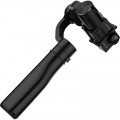Type
—
For smartphone. Mount for using a smartphone as a camera. Most often it is a kind of clamp, in which the body of the device is tightly clamped. Such clamps usually have a fairly wide range of adjustment for the width of the phone, which allows you to use this type of stabiliser with most modern smartphones, regardless of the diagonal. And some models can even work with compact digital cameras.
—
For camera. Attachments designed for use with full-size cameras — SLR and mirrorless (MILC). Such cameras are quite large and have a thread mount for a tripod. All these features are taken into account in the design of the stabiliser.
—
For action cameras. Stabilisers designed for action cameras — compact cameras used mainly for shooting dynamic scenes like sports, skiing, cycling, etc. Such devices, by definition, are designed for use in rather extreme activities, including surfing, skiing, paragliding, etc. However, the specific features of different stabilisers may be different, so before buying it's ok to clarify this matter separately. Note that instead of the general name “for action camera”, the stabiliser specifications may contain the names of specific models of action cameras for which the device is designed.
—
With camera. Stabilizers equipped with their own cameras. These are integrated directly int
...o the stabilizer's construction, eliminating the need for external devices for filming. Moreover, such models are inherently optimized for working with the built-in camera — at the very least, the user doesn't have to deal with balancing the load on the stabilizer's head. Note that the ability to remove and replace the camera with another is usually not provided, although there are occasional exceptions to this rule.Max. load
The maximum weight that the stabiliser is designed to carry.
This is the maximum weight of the camera with all accessories allowed for this model.
Rotation angle
The range of rotation angles supported by the steadicam.
In this case, it means turning the camera to the right or left, without tilting back and forth.
Bank angle
The range of roll angles (to the side) supported by the stabiliser.
Can be recorded in two ways (See "Tilt angle")
Max. phone diagonal
The maximum diagonal of the phone that can be installed on this stabiliser.
This parameter is more relevant for models for various purposes, not only for those that were originally designed for smartphones. Here we note that the maximum diagonal is a rather approximate parameter: models with the same screen size may have different actual dimensions.
Capacity
The capacity of the battery used in the stabiliser.
In theory, a higher capacity allows you to work longer without recharging, but the battery life of the stabiliser also depends on its power consumption. So, only models with similar performance characteristics can be compared with each other according to this indicator; and when choosing, it is better to focus not on the capacity, but on the directly claimed battery life.
Battery life
The maximum length of time the device will work before it needs its battery to be recharged. It is worth considering that the manufacturer indicates the maximum time, which does not correspond to real indicators due to the conditions and intensity of use.
Connection
There are two main types of connection in modern stabilisers:
Wi-Fi(more precisely, Wi-Fi Direct — for direct communication between devices) and
Bluetooth. Despite the difference from a technical point of view, in this case, these standards are very similar. First, they are both wireless. Secondly, both are used for direct connection with devices installed on the stabiliser — smartphones, action cameras, etc. (for more details, see "Features"). Thirdly, the specific functions of such a connection may be different, they should be specified separately for each model. However, such functions usually include at least control over the recording process (start/pause video recording, capture photos). So the main selection criterion for this indicator is what technology the connected gadget supports — Wi-Fi or Bluetooth.
Separately, we note that there are stabilisers that support both standards at once — these are mainly expensive professional models for cameras (see "Features"), where Wi-Fi is used to transfer video to an external screen, and Bluetooth is used for basic remote control.

